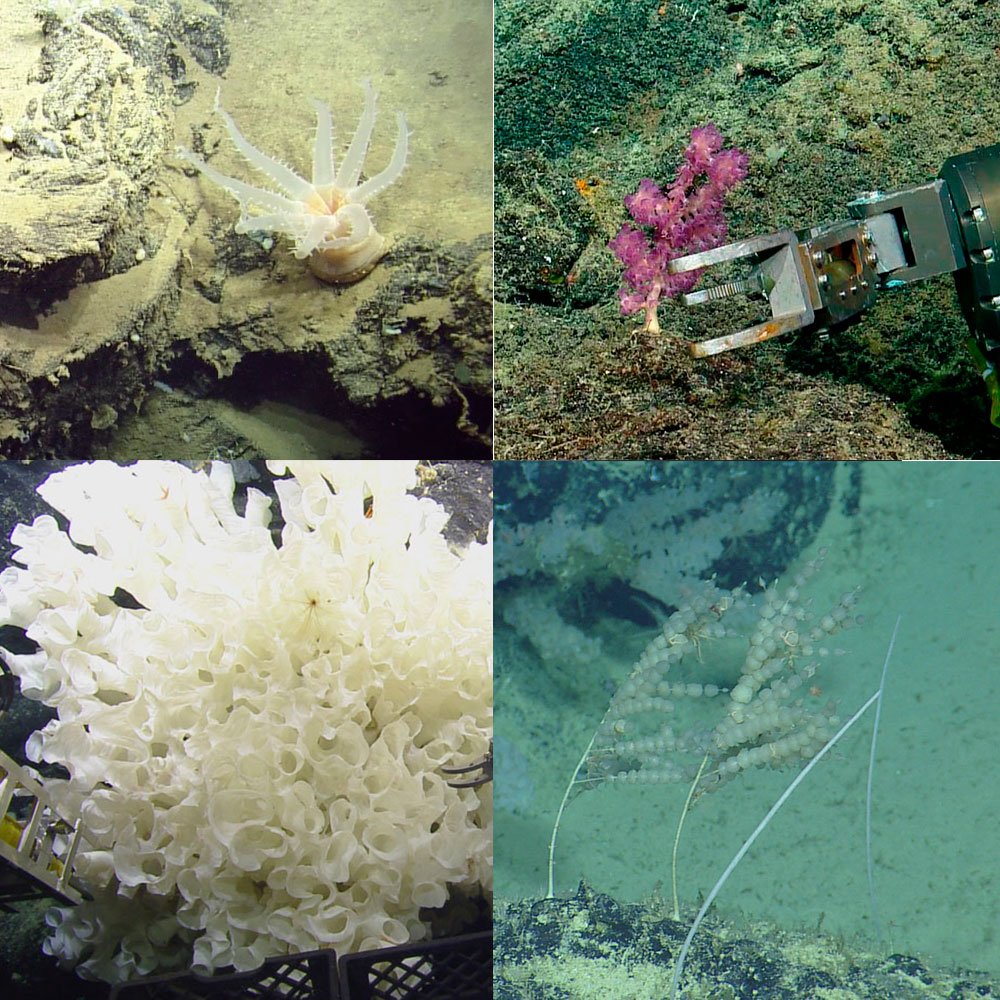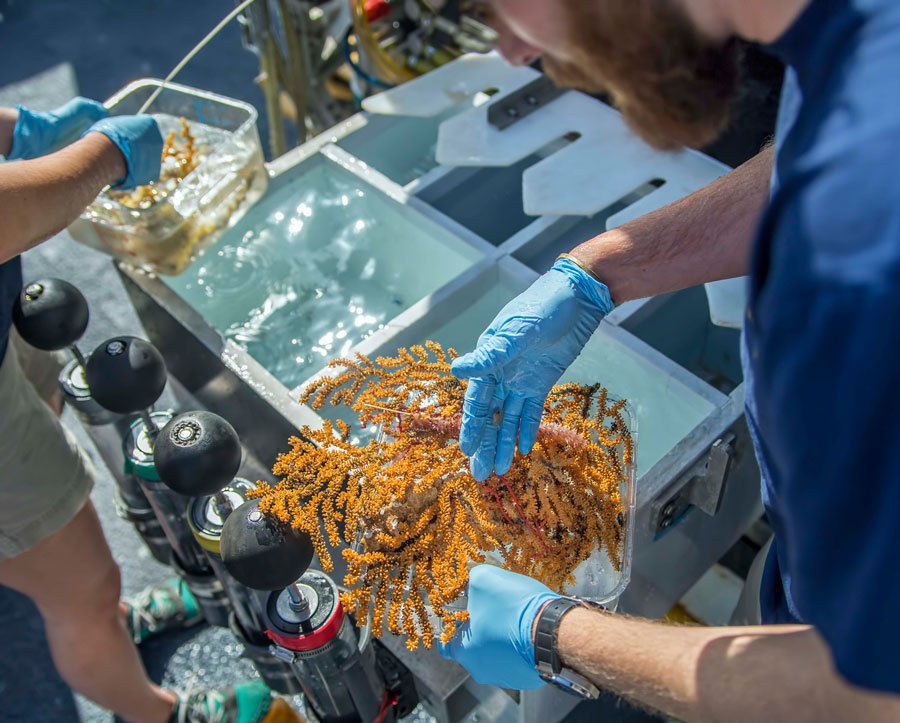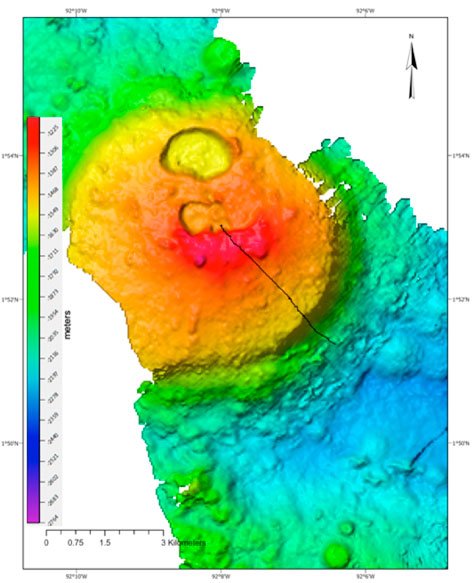
The World that Darwin never saw: 30 new deep-sea invertebrates discovered within the Galapagos Marine Reserve
For the first time, scientists from the Charles Darwin Foundation (CDF), in collaboration with the Galapagos National Park Directorate, the Ocean Exploration Trust and an international team of deep-sea experts have discovered fragile coral and sponge communities hosting thirty deep-sea invertebrate species that are new to science. Owing to its volcanic origins, seamounts – underwater mountains that do not break the surface of the ocean - are prominent features of the deep seafloor of the Galapagos Islands and until recently, these extinct volcanoes and the biological communities that live on them, have remained largely unexplored.
These discoveries are the result of one of the most comprehensive scientific expeditions to characterize deep-water ecosystems of the Galapagos to depths of up to 3,400 m using state-of-the-art Remote Operated Vehicles (ROVs) aboard the E/V Nautilus. New species include four squat-lobsters, ten bamboo corals, four octocorals, one brittle star and eleven sponges. These discoveries include the first giant solitary soft coral known for the Tropical Eastern Pacific, a new genus of glass sponge that can grow in colonies of over one meter in width and, colorful sea fans that host a myriad of associated species. Results from the expedition have been published today in the journal Scientific Reports.

“These are very exciting discoveries and the result of the combined hard work of a multidisciplinary team of researchers” says Dr. Pelayo Salinas de León, Senior Marine Scientist at the CDF and conservation scientist at the National Geographic Pristine Seas project, who led the study. “The deep sea remains as earth’s last frontier and this study provides a sneak-peak into the least known communities of the Galapagos Islands. These pristine seamounts are within the Galapagos Marine Reserve and are protected from destructive human practices such as fishing with bottom trawls or deep-sea mining that are known to have catastrophic impacts upon fragile communities. Now it is our responsibility to make sure they remain pristine for the generations to come."

Analysis of the video collected by the ROVs revealed the presence of a range of underwater communities between depths of 290 and 3,373 m, including the presence of multiple fragile habitats, such as glass sponge gardens, coral gardens and cold-water coral colonies, that are considered Vulnerable Marine Ecosystems (VMEs) by the United Nations General Assembly.
“Seamounts are steep-sided underwater mountains formed from volcanic rock that generate complex currents compared to the surrounding flat seafloor,” explains Dr Leigh Marsh from the University of Southampton. “It is a combination of this topography along with a supply of food that falls from the surface ocean that creates favorable conditions for a diverse array of deep-sea communities to thrive.”

“These dives revealed some of the most unusual deep-sea octocorals we have seen. These new species will contribute to establishing the uniqueness of the deep-sea fauna in the Tropical Eastern Pacific,” commented Dr. Les Watling from the University of Hawaii at Manoa.
This research was conducted during a 10-day cruise aboard the E/V Nautilus, a 64-meter research vessel specializing in conducting scientific deep-sea exploration of the unknown ocean to a depth of 4000 m using the two-body Remotely Operated Vehicle (ROV) system Argus and Hercules. Biological and geological specimens were collected using the ROV manipulator arm and suction samplers and placed on sample boxes aboard Hercules ROV for recovery. When the ROVs were back on deck, individual organisms were separated, photographed and stored. At the end of the expedition, specimens were sent to renowned deep-sea experts for identification.

“The many discoveries made on this expedition showcase the importance of deep-sea exploration to developing an understanding of our oceans and the power of telepresence to build a diverse team of experts," says Dr. Nicole Raineault, Chief Scientist of the Ocean Exploration Trust. “Since we never know what we’re going to find, we utilize land-based scientists who watch the ROV dives from home and communicate directly with the shipboard team in real time, to help determine what is truly new and worthy of further investigation or sampling. Scientists studying the resulting video, data, and specimens make an astonishing number of discoveries, reminding us how little we know about the deep sea.”

This research was possible thanks to the support of NOAA Office of Exploration and Research for funding the E/V Nautilus Exploration Program, the Helmsley Charitable Trust and the Gordon and Betty Moore Foundation.




